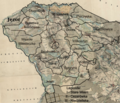Jęzor
| Jęzor | ||
|---|---|---|
 Help on coat of arms |
|
|
| Basic data | ||
| State : | Poland | |
| Voivodeship : | Silesia | |
| District of: | Sosnowiec | |
| Geographic location : | 50 ° 14 ' N , 19 ° 10' E | |
| Residents : | ||
| Telephone code : | (+48) 32 | |
| License plate : | SO | |
Jęzor is a small and the southernmost district of Sosnowiec in the Silesian Voivodeship in Poland .
history
According to a local tradition, the settlement was founded by residents of Niwka around 1590, including the miller Mateusz Sośnierz, whose nickname Jęzor became the name of the village. According to Maria-Leś Runicka, however, the place was founded by Jews who wanted to trade with Prussia .
Until 1790 Jęzor was a hamlet of Dąbrowa (Narodowa) (now a district of Jaworzno ) in the estates of the town of Sławków , which belonged to the Kraków bishops . Administratively, the hamlet was in the district of Proszowice or Kraków of the Kraków Voivodeship in the Kingdom of Poland (from 1569 aristocratic republic of Poland-Lithuania ).
When Poland was partitioned for the third time in 1795, it became part of the Habsburg Empire . In the years 1815–1846 it belonged to the Republic of Krakow , in 1846 it was annexed again to the countries of the Austrian Empire as part of the Grand Duchy of Krakow . In 1847 the Kraków-Upper Silesian Railway was opened by Jęzor (today part of the Jaworzno Szczakowa – Mysłowice railway ). After the abolition of patrimonial it belonged to the Dąbrowa municipality in the Jaworzno judicial district in the Chrzanów district , but later it became part of Jaworzno. According to the Austrian census, there was a primary school and a financial control in Jęzor in 1900.
The hamlet of Jęzor was located south of the state White Przemsa and southeast of the confluence of the Black and White Przemsa rivers, which became a triangle , a tourist attraction from the end of the 19th century.
In the interwar period , the community belonged to the Powiat Chrzanowski of the Krakow Voivodeship . Jęzor was parish in the Roman Catholic parish. At that time, their inhabitants were mocked as Galizers in Niwka . During the attack on Poland in 1939, the area was occupied by the Germans and assigned to the district of Krenau in the new "East Upper Silesia".
1953 Jęzor was spun off under Bolesław Bierut without the consent of the residents of Jaworzno in the Kraków Voivodeship and incorporated into the city of Sosnowiec in the Stalinogród (Katowice) Voivodeship (simultaneously with Niwka). In the next year, however, the community Dąbrowa Narodowa was completely attached to the city of Jaworzno. Jęzor remained the only district of Sosnowiec that belonged to the Austro-Galician Zagłębie Krakowskie (about Kraków mining district ) and not to the Dombrowa coal basin in the Russian-dominated Congress Poland .
Dąbrowa and Jęzor on the Franzisco-Josephinische Landaufnahme around 1870
A photo from 1914 from the Dreikaisereck with the view from the German bank of the Przemsza in the Austrian direction towards Jęzor or Dąbrowa
Individual evidence
- ↑ a b Anna Zielonka, Tomasz Szymczyk: Jęzor: Zagłębiacy contra Galicjoki, czyli domy w Sosnowcu, ale serca - w Jaworznie , April 6, 2015, an article about the regional animosity between the "Galician" inhabitants of Jęzor and the rest of the inhabitants of Sosnowiec in the Dziennik Zachodni newspaper (Polish);
- ↑ Ludwig Patryn (Ed.): Community encyclopedia of the kingdoms and countries represented in the Reichsrat, edited on the basis of the results of the census of December 31, 1900, XII. Galicia . Vienna 1907 ( online ).
- ↑ Dz.U. z 1953 r. no 41, poz. 186.
Web links
- Anna Zielonka, Tomasz Szymczyk: Jęzor: Zagłębiacy versus Galicjoki, czyli domy w Sosnowcu, ale serca - w Jaworznie , April 6, 2015, an article about the regional animosity between the "Galician" inhabitants of Jęzor and the rest of the inhabitants of Sosnowiec in the Dziennik Zachodni newspaper (Polish);




